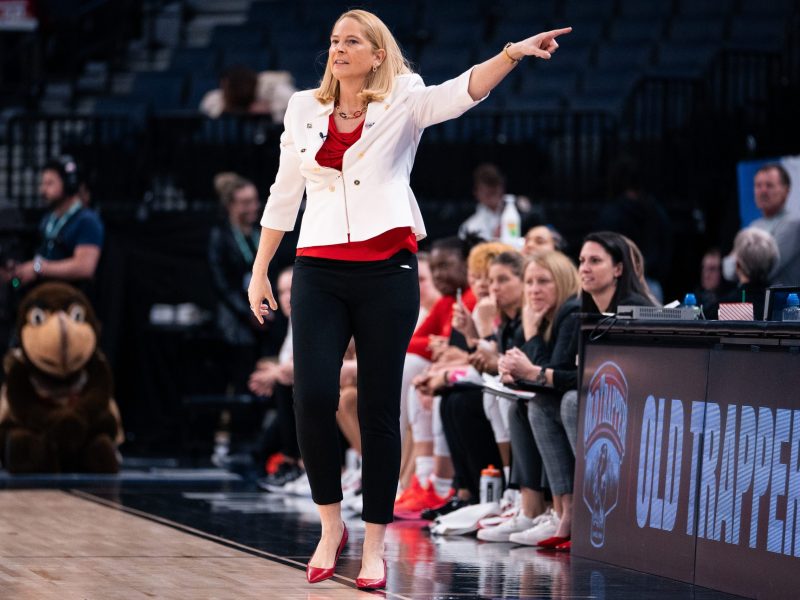Four glass doors sit one floor below the public health school’s lobby, marking the entryway into a large, old and colorful gym.
Maryland gymnastics trains here from 1 to 4 p.m. four times a week, using the array of oddly-shaped mats and equipment to prepare for Big Ten battles. The sport’s individual nature requires a unique practice structure. The Terps’ is detail-oriented, with each gymnast getting individual attention, but maintains an energetic and joyful atmosphere throughout.
The gymnasts start practice by forming a circle and bumping a volleyball to each other while shuffling their feet to warm up. A mix of 2010s hits from senior Alexa Rothenbuescher’s playlist blares, readying the gymnasts for the next three hours.
“The energy is always good at practice,” sophomore Taylor Rech said. “It’s super loud and positive … we’re always having fun.”
The Terps stretch and then end warmups by seeing who can hold a handstand the longest.
While this happens, Maryland’s coaches assemble at four whiteboards — one for each event. They put the names into a random generator to create three groups of six or seven gymnasts. Each group will spend about 30 to 40 minutes working on an event before rotating.
The Terps work on three events each day. They always practice uneven bars and beam but alternate vault and floor each practice.
[Small mistakes led to Maryland gymnastics’ worst performance of the season]
“Every day, every week, they’re maybe in a different order of events that they do with a different group of people,” coach Brett Nelligan said. “That keeps it light and fun.”
Earlier in the week, gymnasts hone in on specific skills. But as Maryland gets closer to competition, it begins practicing its full routine.
Since the Terps can win or lose meets by tenths, it is important to split up the routines, fifth-year Emma Silberman said. Putting details together at the end of the week gives Maryland a confidence boost, Silberman added.
Three of the Terps’ four coaches have designated roles during practice. Nelligan watches the gymnasts on uneven bars. Assistant coach Erinn Dooley focuses on beam. JJ Ferreira, another assistant, works with floor or vault depending on what Maryland’s third event is that day. Assistant coach Morgan Epps helps wherever needed.
But having just four coaches, three sets of bars and three beams forces the Terps’ 21 gymnasts to take turns. Rather than wasting time by waiting around, they use technology to refine their technique.
An iPad sits next to each event and records the gymnasts so they can review film while their teammates practice the rotation.
Such methods are crucial so Maryland can maximize limited practice time. The NCAA caps in-season practice time at 20 hours per week. Nelligan doesn’t hit that mark and formats practices intentionally to prevent injuries.
[Maryland gymnastics posts season-low 195.100 in last-place finish at Big Five Meet]
“When you’re younger and you’re doing gymnastics, I think your body can hit a lot more,” Nelligan said. “At this point in their careers, when you’re 18, 19, 21, 22 years old, doing 25 to 30 hours a week is too much on the body.”
Silberman said she loves how the practices allow for more attention to detail and individual feedback. Having coaches who focus on one event is helpful because they stay with each gymnast day in and day out, she said.
Three events and nearly two and a half hours later, practice nears its end, but the Terps’ intensity increases.
They finish with a 20 minute conditioning session. The athletes cycle through various tasks like pullups, handstand taps against the wall and push ups.
“We have a pattern that we follow,” sophomore Maddie Komoroski said. “I wouldn’t say that anyone really likes it, but we’ll blast the music behind, put on a good playlist that we want and everyone’s screaming things like, ‘C’mon Terps!’ so it makes it a little more enjoyable.”
Even in an individual sport like gymnastics, Maryland’s team camaraderie helps it through long practices.
“There’s really no tough part [about practice] because we always have a positive attitude, no matter what we do,” Rech said. “Even when it’s a slower day in the gym, someone’s always there to be like, ‘Hey, how are you doing?’ and pick up the other person.”
That spirit is evident when the Terps wrap up. They stretch in a group and chant “Way to go Terps!” together before filing out — ready to repeat the routine soon after.



